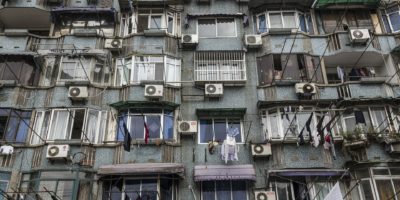The world is warming, incomes are rising, and smaller families are living in larger houses in hotter places. One result is a booming market for air conditioning — world sales in 2011 were up 13 percent over 2010, and that growth is expected to accelerate in coming decades.
By my very rough estimate, residential, commercial, and industrial air conditioning worldwide consumes at least one trillion kilowatt-hours of electricity annually. Vehicle air conditioners in the United States alone use 7 to 10 billion gallons of gasoline annually. And thanks largely to demand in warmer regions, it is possible that world consumption of energy for cooling could explode tenfold by 2050, giving climate change an unwelcome dose of extra momentum.
The United States has long consumed more energy each year for air conditioning than the rest of the world combined. In fact, we use more electricity for cooling than the entire continent of Africa, home to a billion people, consumes for all purposes. Between 1993 and 2005, with summers growing hotter and homes larger, energy consumed by residential air conditioning in the U.S. doubled, and it leaped another 20 percent by 2010. The climate impact of air conditioning our buildings and vehicles is now that of almost half a billion metric tons of carbon dioxide per year.
Yet with other nations following our lead, America’s century-long reign as the world cooling champion is coming to an end. And if global consumption for cooling grows as projected to 10 trillion kilowatt-hours per year — equal to half of the world’s entire electricity supply today — the climate forecast will be grim indeed.
Because it is so deeply dependent on high-energy cooling, the United States is not very well positioned to call on other countries to exercise restraint for the sake of our common atmosphere. But we can warn the world of what it stands to lose if it follows our path, and that would mean making clear what we ourselves have lost during the age of air conditioning. For example, with less exposure to heat, our bodies can fail to acclimatize physiologically to summer conditions, while we develop a mental dependence on cooling. Community cohesion also has been ruptured, as neighborhoods that on warm summer evenings were once filled with people mingling are now silent — save for the whirring of air-conditioning units. A half-century of construction on the model of refrigerated cooling has left us with homes and offices in which natural ventilation often is either impossible or ineffective. The result is that the same cooling technology that can save lives during brief, intense heat waves is helping undermine our health at most other times.
China is expected to surpass the U.S. as the world’s biggest user of electricity for air conditioning by 2020.
The time window for debating the benefits and costs of air conditioning on a global scale is narrowing — once a country goes down the air-conditioned path, it is very hard to change course.
China is already sprinting forward and is expected to surpass the United States as the world’s biggest user of electricity for air conditioning by 2020. Consider this: The number of U.S. homes equipped with air conditioning rose from 64 to 100 million between 1993 and 2009, whereas 50 million air-conditioning units were sold in China in 2010 alone. And it is projected that the number of air-conditioned vehicles in China will reach 100 million in 2015, having more than doubled in just five years.
As urban China, Japan, and South Korea approach the air-conditioning saturation point, the greatest demand growth in the post-2020 world is expected to occur elsewhere, most prominently in South and Southeast Asia. India will predominate — already, about 40 percent of all electricity consumption in the city of Mumbai goes for air conditioning. The Middle East is already heavily climate-controlled, but growth is expected to continue there as well. Within 15 years, Saudi Arabia could actually be consuming more oil than it exports, due largely to air conditioning. And with summers warming, the United States and Mexico will continue increasing their heavy consumption of cool.
Countries are already struggling to keep up with peak power demand in hot weather. This summer, India is seeing a shortfall of 17 gigawatts, with residential electricity shut off for 16 hours per day in some areas. China is falling short by 30 to 40 gigawatts, resulting in energy rationing and factory closings.
In most countries, the bulk of electricity that runs air conditioners in homes and businesses is generated from fossil fuels, most prominently coal. In contrast, a large share of space heating in cooler climates is done by directly burning fuels — usually natural gas, other gases, or oil, all of which have somewhat smaller carbon emissions than coal. That, together with the energy losses involved in generation and transmission of electric power, means that on average, an air conditioner causes more greenhouse emissions when pushing heat out of a house than does a furnace when putting the same quantity of heat into a house.
Based on projected increases in population, income, and temperatures around the world, Morna Isaac and Detlef van Vuuren of the Netherlands Environmental Assessment Agency predict that in a warming world, the increase in emissions from air conditioning will be faster than the decline in emissions from heating; as a result, the combined greenhouse impact of heating and cooling will begin rising soon after 2020 and then shoot up fast through the end of the century.
Refrigerants — fluids that absorb and release heat efficiently at the right temperatures — are the key to air conditioning and refrigeration, but they can also be serious troublemakers when released into the atmosphere. Refrigerants such as chlorofluorocarbons (CFCs) that harm the stratospheric ozone layer are being phased out under the 1989 Montreal Protocol; however, most ozone-friendlier substitutes are, like CFCs, powerful greenhouse gases.
The U.S. experience provides little hope that renewable energy can satisfy a growing share of air conditioning demand.
Most prominent worldwide in the new generation of refrigerants are compounds known as hydrofluorocarbons (HFCs). They have a smaller climate-warming potential than do the ozone-depleting compounds they are replacing, but they still have hundreds to thousands of times the greenhouse potency of carbon dioxide (on a pound-for-pound basis, that is; carbon dioxide is released in vastly larger quantities and has a larger total impact.) Rapid growth in air conditioning threatens to swamp out the marginal climate benefits of replacing current refrigerants with HFCs.
According to a recent forecast by Guus Velders of the Netherlands’ National Institute for Public Health and the Environment and his colleagues, refrigerants that accumulate in the atmosphere between now and 2050 (increasingly HFCs, mostly from refrigeration and air conditioning) will add another 14 to 27 percent to the increased warming caused by all human-generated carbon dioxide emissions. Recent years, therefore, have seen a research stampede to find refrigerants with lighter greenhouse potential. Several promising candidates have been discarded on the basis of flammability, toxicity, ozone depletion, or other problems. None of the remaining prospects is ideal in all respects.
One important consideration is efficiency. A refrigerant that has smaller direct greenhouse potential than those currently in use but that exchanges heat less efficiently — causing an air conditioner to consume more energy for the same amount of cooling — could have a larger total climate impact.
Isaac and Van Vuuren predict that even if demand for air conditioning is satisfied with successively more efficient generations of equipment, global electricity consumption for home cooling will still rise eightfold by 2050, which is not much better than the tenfold increase that would occur without efficiency improvements. A similar dominance of growth over efficiency has prevailed in the United States. From 1993 to 2005, energy efficiency of air-conditioning equipment improved by almost 30 percent, but household energy consumption for air conditioning doubled.
There is hope that renewable energy could satisfy a growing share of air-conditioning demand, but there is little inspiration to be drawn from the U.S. experience. Here, renewable electricity production from wind, solar, biomass, and geothermal sources could expand to five times its current production (an increase that the Environmental Protection Agency does not expect to be achieved until 2030) and still not cover the nation’s air-conditioning demand, let alone other needs. Today, worldwide renewable production is estimated at about 750 billion kilowatt hours, which, I estimate, covers about three-fourths of current global air-conditioning demand. The International Energy Agency predicts that renewable generation will expand to six times its current output by 2050. But even if that is achieved, renewable sources will still be satisfying only three-fourths of air-conditioning demand.
Is it fair to expect people in Mumbai to go without air conditioning when so many in Miami use it freely?
Each supply-side option has its own problems. Attempts to catch up with cooling demand by expanding hydroelectric power generation have caused serious ecological disruption and displacement of many millions of rural people in India, China, Brazil, and other countries. And we see hints that proliferation of air conditioning will provide an incentive to revive and expand nuclear power. Last month, in the face of strong opposition from the public, Japanese Prime Minister Yoshihiko Noda announced that his government was ending the moratorium on nuclear energy generation that had been in place since the tsunami disaster at the Fukushima Daiichi nuclear power plant in 2011. Noda acknowledged that the timing of the restart of two reactors in western Japan was no accident; the additional power will be needed to satisfy the summer surge in air conditioner use.
In thinking about global demand for cooling, two key questions emerge. Is it fair to expect people in Mumbai to go without air conditioning when so many in Miami use it freely? And if not, can the world find ways to adapt to warmer temperatures that are fair to all and do not depend on the unsupportable growth of air conditioning?
Currently, efforts to develop low-energy methods for warm climates are in progress on every continent. Passive cooling projects in China, India, Egypt, Iran, Namibia, and other countries combine traditional technologies — like wind towers and water evaporation — with newly designed, ventilation-friendly architectural features. Solar adsorption air conditioning performs a magician’s trick, using only the heat of the sun to cool the indoor air, but so far it is not very affordable or adaptable to home use. Meanwhile in India and elsewhere, cooling is being achieved solely with air pumped from underground tunnels.
But non-refrigerated climate control, especially in hot climates, cannot consistently achieve comfort that satisfies the industrial definition; in other words, it doesn’t produce the kind of cool, still, dry air that prompts many Americans to wear sweaters at work in July. A shift toward natural cooling will mean relying on humans’ well-proven capacity to adapt to variable conditions. Studies in the tropics have found, for example, that office workers are well satisfied with natural ventilation and warmer temperatures, if they have not already been conditioned by air conditioning.
Whatever course the world follows in adapting to a hotter planet — universal high-efficiency air conditioning; tighter construction; all-out pursuit of renewable, hydroelectric, or nuclear energy; or rebuilding and retrofitting entire societies for non-refrigerated cooling — the cost in both money and physical resources will be staggering. Deciding on the best strategy, and soon, will be crucial.



